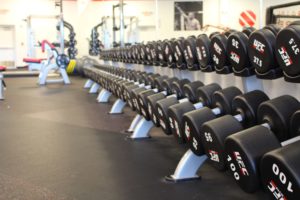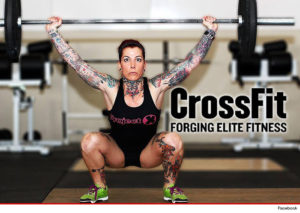The world of health and fitness is frequently challenging for bodies that do not fit a specific mold. Gyms are filled with subtle and not-so-subtle judgments against those who vary from a norm, especially a gendered norm. Health and fitness environments seem to invite judgment of the body from all directions – internal, external, and everything in between. Yet at the same time, building a positive relationship with exercise and movement can provide a vital boost to one’s mental and physical health. How do trans people navigate such a precarious environment?
This blog post seeks to ask how fitness environments are currently lacking or dangerous; what they could offer for trans people; and how they could be improved. To tackle these questions, we will use the body as an organizational conceit. The section “rogue bodies” talks about the ways in which health and fitness environments mark trans bodies as divergent, rogue or undesirable, and try to exclude or police them. The section “body-minds” (borrowing a term from the activist Eli Clare) engages the mental health aspect of fitness, and how trans people may internally relate to their bodies. Finally, the section “bodies in motion” discusses how trans people act to reduce or combat the discrimination in fitness spaces.

https://ufcgym.com/naperville
Rogue Bodies
Trans people face specific challenges in navigating the world of health and fitness, both in terms of achieving and maintaining a positive mindset toward fitness and in terms of accessing fitness supports. The fitness and sports world still caters to privileged populations- there remains a risk that trans athletes will not be allowed to compete in the division of the gender with which they identify, and the bathroom problem extends to gyms and fitness facilities as well- trans people are at risk for being discriminated against or attacked for using a locker room or bathroom at a gym. There are steps that can be taken to improve this issue and a lot of them have to do with empowerment and giving trans people space and leadership in fitness- trans people having the resources and opportunities to become personal trainers, coaches, and athletes.
One part of the oppression that trans people face is their experience in fitness spaces. Many fitness professionals, facility staff and event organizers lack understanding – or a desire to understand – the needs of trans people. For example, in 2013, a trans woman named Chloie Jonsson was at the center of a controversy with CrossFit. In the spring of 2013 she was told by CrossFit Games general manager Justin Bergh that competitors must register under their gender assigned at birth. CrossFit’s general counsel later confirmed that she would “need to compete in the Men’s Division.” Jonsson, who medically transitioned almost 20 years ago at the age of 16, is suing CrossFit for discrimination, intentional infliction of emotional distress, and unfair competition.

http://www.tmz.com/2014/05/19/crossfit-transgender-chloie-jonnson/
In gym environments, the pressure to pass can be immense. Speaking to Cosmo, Amelia Gapin recounts her experiences with this: “When I went to pick up my race packet in person, it was incredibly nerve-wracking: I was presenting myself as a woman, but had to flash an old ID with my male birth name and photo of myself looking like a male. While all the other runners battled pre-race jitters, I worried about whether my identity would be questioned.”
Gapin’s account shows several layers of oppression. First, there is the fear of being kicked out of a race or competition because of gender, like Jonsson experienced with CrossFit. There are also dangers associated with locker rooms – as Gapin notes, “I’m lucky that nothing traumatic has ever happened to me in the locker room — it’s probably because I pass for a woman very well and a lot of people have no idea that I’m transgender.” Once again, the importance of passing becomes a matter of autonomy and safety. It can determine whether you’re allowed to participate as yourself or even at all in a fitness environment. Because locker rooms are intimate, exposed spaces, any gender variation can be especially dangerous for those who are seen as “trespassing”.
Outside of the competitive fitness world, trans people face numerous attempts to police the aesthetic fitness of their bodies. One of these has to do with medicalization. This Mashable article talks about how in order to medically transition, trans people will often need to lose or gain weight. This means they need access to gyms and personal trainers, which is often difficult in practice. One such situation is described: “Fifty pounds is a high bar for anyone to meet, but it was a particular obstacle for Parker who, at the time of his transition, was struggling with severe depression and body dysmorphia. Living in the rural South, he didn’t have a trans-friendly gym nearby. Parker hired several different personal trainers, but they only wanted to ‘reinforce’ traditional gendered fitness aesthetics.”
Body-Minds
The internal experience of exercise is more than a matter of movement and activity. It is also about engaging the aesthetic traits of one’s body, and how these traits are socially situated. This has been the subject of much academic discussion, such as in the work of Micha Cardenas. Such social issues are especially pertinent in fitness environments, which act as fish-bowls for the aesthetic values and judgements of the mainstream. In our current world, these judgments inevitably run towards the transphobic and norm-adherent. Part of the challenge here stems from the complicated relationship trans people have with their bodies. Everyone engages with their bodies along socialized aesthetic and gendered lines. What does it mean to experience dysphoria, gendered or otherwise?
First, we must establish the relationship between gender dysphoria and other forms of body dysphoria and dysmorphia. There is a relationship between gender dysphoria and the lived experience in the body. However, it is important to understand the nuances in these terms. According to this Jezebel article, gender dysphoria is defined as distress due to a mismatch of sex and gender. Body dysmorphia is an anxiety disorder that manifests in obsessive worry about appearance and discomfort in the body. Furthermore, body dysmorphia often results in an inability to see or understand what the body truly looks like (i.e. people thinking they are extremely obese or extremely thin despite their body not looking that way).
It’s easy to assume that all trans and gender-nonconforming people who experience gender dysphoria also have body dysmorphia, but that is not the case. The societal pressures of body image may be at play in their lives, but not all trans lives are impacted with the official disorder. Gender dysphoria can be a body image issue, and it can be connected to body dysmorphia, but none of these three things are inherent to each other.
That said, when gender dysphoria, body dysmorphia and body image do interact, the experience can be brutal. Writing for Medium, Katelyn Burns describes her intersectional experiences with transphobia and fatphobia. She writes that “always those two words appeared together in my thoughts, woman and pretty… to be a woman in our society carries a demand from society to be pretty.” She continues, “In order to stop the impulsive eating, I needed to try to tackle my gender dysphoria. In order to tackle my dysphoria, I needed to overcome my fatphobia.” The dysmorphic label cannot exist without deeper exploration beyond the body to the connection/disconnect between sex and gender.
These overlapping influences can result in dangerous and unhealthy behaviors. While we cannot assume that every time someone experiences gender dysphoria, this will cause them to experience body dysmorphia and/or an eating disorder, the intersection between the three are important to the conversation about fitness and the experience of fitness for a person who is trans.
Bodies in Motion
It is easy to list the problems that trans people face in health and fitness environments. It is not as easy to envision solutions. Thankfully, trans people have already been doing this. One way is by creating welcoming spaces. One such space is Rainbow Health Ontario. Founded by a trans man, it encourages an approach to health that is both trans-friendly and holistic, encouraging moderation, variety and balance. It provides guidelines on how to navigate transphobia and fatphobia, and provides resources for people experiencing these things. Rainbow Health Ontario is an example of how, when the mainstream is unwilling or unable to meet diverse needs, trans people can create their own spaces.

http://www.communitylegalcentre.ca/referrals/LGBTQ.htm
Furthermore, fostering a positive relationship with movement can restore ownership with and connection to the body. It emphasizes the connection between the mind and the body to heal and empower trans people. As one person describes it to Buzzfeed, “I didn’t have the words for it but I knew that I wanted to grow up and be female when I was 5 years old. Yoga has this way of stirring things up, like whatever has been buried and whatever the things are that we are trying to ignore. For me that was that I was trans. It helped me to feel comfortable in my body. I really think yoga is why I’m still alive and why I’m happy and thriving now.” There are many such testimonies like this – another person in the same article says that “because of working out … I went on hormones. It gave me courage. If it wasn’t for fitness, I don’t really think I ever would have transitioned.”
A positive relationship with movement can reinforce a positive relationship with the body. However, exercise alone is not enough. In fact, it can be problematic if done in isolation, taken to extremes. In the Buzzfeed article linked above, none of the athletes discussed prescribed and/or compulsive exercise. They don’t exercise because they feel compelled to do so, but because they love the way it makes them feel about themselves and their body. The compulsory nature of physique and vanity-based strength training and working out is not the driving factor for these athletes. This is important for establishing and reinforcing overall positivity associated with the athlete’s sport and ideas about movement. For people just getting started with exercise, the benefits of fitness must be built upon a firm foundation of mental health so that they can experience the effects with positivity like the athletes interviewed by Buzzfeed. This means that trans people need accessible and high-quality mental health services to accompany fitness. There must be more access to holistic healthcare that isn’t focused solely on weight gain or reduction.
Loving one’s body can also better enable trans people to practice resilience when they do face oppression. In this Buzzfeed article, Alex Gutierrez, a Florida-based fitness trainer, talks about how her high-intensity workout routine “build mental toughness that gave me determination… it gave me courage.” Others in the article describe similar trends, and have become activists. For example, Neo L. Sandia founded the first bodybuilding competition for trans men. Chris Mosier started GO! Athletes, a support group for LGBTQ+ collegiate and high school athletes. Fallon Fox is the first professional MMA fighter to come out as trans. Many of these people describe how exercise has made them more confident, more resilient, and more determined to embrace their identities.
/cdn.vox-cdn.com/assets/2357051/fallon_fox.jpg)
https://www.theverge.com/2013/3/21/4131174/fallon-fox-mma-science-transgender-fighting-athletes
Conclusion
Of course, trans people are far more than their bodies, but to deny the importance of fitness would be dishonest. Lived experience is always, to some degree, physical. Fitness environments highlight the fact that the body, the mind, and the society in which these exist are all deeply connected.
Living in a trans body means navigating the mind/body connection in a markedly different way. It also means dealing with the risk of discrimination or being invalidated in your sport because you are gender nonconforming. Even when discrimination is not actively happening, trans athletes still have to deal with the fact that the risk for discrimination is always there.
It is important for cis trainers, coaches, and fitness professionals to not only be accepting but to fight for the opportunity for trans athletes to compete and participate with the gender they identify with as well as give trans athletes the opportunity to become the certified professionals that lead and set the example in the fitness world.
Julia Wicks, Arika Thames, & Hannah Caffacus
This post was super interesting and informative! I have stumbled across several trans internet personalities who gained internet frame from fitness-based posts. Reading their accounts, I definitely have seen stories of how some have faced discrimination from gym employees and also how focusing on fitness can be a great way to connect with your body in a meaningful way. It’s great to hear examples of trans-friendly gyms and fitness spaces, but I wonder still how most gyms, that still relied on gendered fitness standards, have gendered spaces like locker rooms, and rely on binary gender to develop training regimens can move past this – and what a redesigned gym space would look like with an acknowledgement of the diversity of genders and bodies that are seeking a space to be fit. Would creating gender neutral locker rooms (like gender neutral bathrooms) be a good start? Do those exist places?